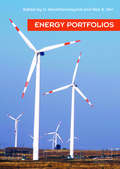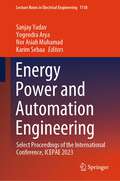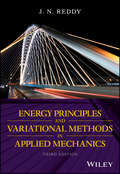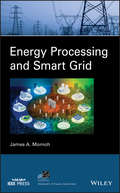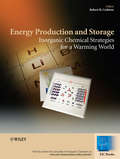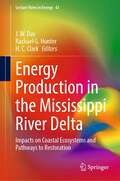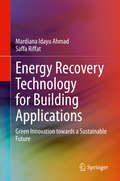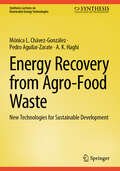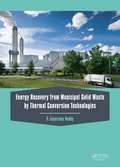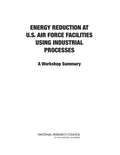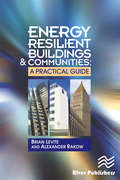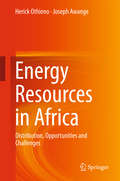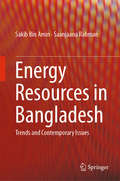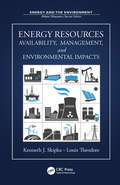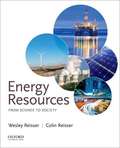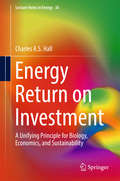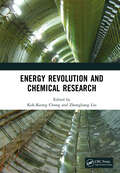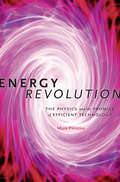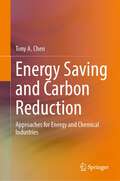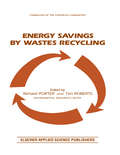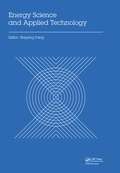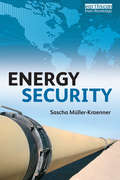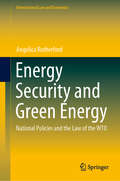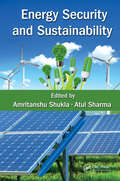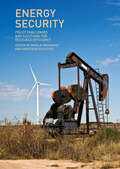- Table View
- List View
Energy Portfolios
by U. Aswathanarayana Rao S. DiviThis book provides an overview of the globally ongoing research and development efforts to reduce carbon emissions and costs, and to improve the efficiency of emerging energy technologies. It covers current and future research and development of Coal, Oil, Natural Gas, Nuclear Power, and Renewable Energy Resources. The author provides optimal size,
Energy Power and Automation Engineering: Select Proceedings of the International Conference, ICEPAE 2023 (Lecture Notes in Electrical Engineering #1118)
by Sanjay Yadav Yogendra Arya Nor Asiah Muhamad Karim SebaaThis book presents the select proceedings of the 4th International Conference on Energy Power and Automation Engineering, ICEPAE 2023. It focuses on the research of clean energy power, low-carbon technology for power generation, and energy automation technology. The book Enriches understanding by including contributions from leading experts. The book will be useful for researchers and professionals interested in the broad field of power energy.
Energy Principles and Variational Methods in Applied Mechanics
by J. N. ReddyA comprehensive guide to using energy principles and variational methods for solving problems in solid mechanics This book provides a systematic, highly practical introduction to the use of energy principles, traditional variational methods, and the finite element method for the solution of engineering problems involving bars, beams, torsion, plane elasticity, trusses, and plates. It begins with a review of the basic equations of mechanics, the concepts of work and energy, and key topics from variational calculus. It presents virtual work and energy principles, energy methods of solid and structural mechanics, Hamilton’s principle for dynamical systems, and classical variational methods of approximation. And it takes a more unified approach than that found in most solid mechanics books, to introduce the finite element method. Featuring more than 200 illustrations and tables, this Third Edition has been extensively reorganized and contains much new material, including a new chapter devoted to the latest developments in functionally graded beams and plates. Offers clear and easy-to-follow descriptions of the concepts of work, energy, energy principles and variational methods Covers energy principles of solid and structural mechanics, traditional variational methods, the least-squares variational method, and the finite element, along with applications for each Provides an abundance of examples, in a problem-solving format, with descriptions of applications for equations derived in obtaining solutions to engineering structures Features end-of-the-chapter problems for course assignments, a Companion Website with a Solutions Manual, Instructor's Manual, figures, and more Energy Principles and Variational Methods in Applied Mechanics, Third Edition is both a superb text/reference for engineering students in aerospace, civil, mechanical, and applied mechanics, and a valuable working resource for engineers in design and analysis in the aircraft, automobile, civil engineering, and shipbuilding industries.
Energy Processing and Smart Grid (IEEE Press Series on Power Engineering)
by James A. MomohThe first book in the field to incorporate fundamentals of energy systems and their applications to smart grid, along with advanced topics in modeling and control This book provides an overview of how multiple sources and loads are connected via power electronic devices. Issues of storage technologies are discussed, and a comparison summary is given to facilitate the design and selection of storage types. The need for real-time measurement and controls are pertinent in future grid, and this book dedicates several chapters to real-time measurements such as PMU, smart meters, communication scheme, and protocol and standards for processing and controls of energy options. Organized into nine sections, Energy Processing for the Smart Grid gives an introduction to the energy processing concepts/topics needed by students in electrical engineering or non-electrical engineering who need to work in areas of future grid development. It covers such modern topics as renewable energy, storage technologies, inverter and converter, power electronics, and metering and control for microgrid systems. In addition, this text: Provides the interface between the classical machines courses with current trends in energy processing and smart grid Details an understanding of three-phase networks, which is needed to determine voltages, currents, and power from source to sink under different load models and network configurations Introduces different energy sources including renewable and non-renewable energy resources with appropriate modeling characteristics and performance measures Covers the conversion and processing of these resources to meet different DC and AC load requirements Provides an overview and a case study of how multiple sources and loads are connected via power electronic devices Benefits most policy makers, students and manufacturing and practicing engineers, given the new trends in energy revolution and the desire to reduce carbon output Energy Processing for the Smart Grid is a helpful text for undergraduates and first year graduate students in a typical engineering program who have already taken network analysis and electromagnetic courses.
Energy Production and Storage
by Robert H. CrabtreeEnergy production and storage are central problems for our time. In principle, abundant energy is available from the sun to run the earth in a sustainable way. Solar energy can be directly harnessed by agricultural and photovoltaic means, but the sheer scale of the energy demand poses severe challenges, for example any major competition between biomass production and food production would simply transfer scarcity from energy to food. Indirect use of solar energy in the form of wind looks also promising, especially for those regions not blessed with abundant sunlight. Other modes such as tidal and wave energy may well become important niche players.Inorganic chemistry plays a decisive role in the development of new energy technologies and this Volume covers some promising modes of alternative energy production and storage that minimize the atmospheric burden of fossil-derived carbon monoxide. No one production or storage mode is likely to dominate, at least at first, and numerous possibilities need to be explored to compare their technical feasibility and economics. This provides the context for a broad exploration of novel ideas that we are likely to see in future years as the field expands.This Volume covers a wide range of topics, such as: - Water splitting, only water is a sufficiently cheap and abundant electron source for global exploitation; - Energy conversion by photosynthesis; - Molecular catalysts for water splitting; - Thermochemical water splitting; - Photocatalytic hydrogen production; - Artificial photosynthesis, progress of the Swedish Consortium; - Hydrogen economy; - Reduction of carbon dioxide to useful fuels; - Conversion of methane to methanol; - Dye sensitized solar cells; - Photoinitiated electron transfer in fuel cells; - Proton exchange membranes for fuel cells; - Intermediate temperature solid oxide fuel cells; - Direct Ethanol fuel cells; - Molecular catalysis for fuel cells; - Enzymes and microbes in fuel cells; - Li-Ion batteries; - Magic Angle Spinning NMR studies of battery materials; Supercapacitors and electrode materials.About EIC BooksThe Encyclopedia of Inorganic Chemistry (EIC) has proved to be one of the defining standards in inorganic chemistry, and most chemistry libraries around the world have access either to the first or second print edition, or to the online version. Many readers, however, prefer to have more concise thematic volumes, targeted to their specific area of interest. This feedback from EIC readers has encouraged the Editors to plan a series of EIC Books, focusing on topics of current interest. They will appear on a regular basis, and will feature leading scholars in their fields. Like the Encyclopedia, EIC Books aim to provide both the starting research student and the confirmed research worker with a critical distillation of the leading concepts in inorganic and bioinorganic chemistry, and provide a structured entry into the fields covered.This volume is also available as part of Encyclopedia of Inorganic Chemistry, 5 Volume Set.This set combines all volumes published as EIC Books from 2007 to 2010, representing areas of key developments in the field of inorganic chemistry published in the Encyclopedia of Inorganic Chemistry. Find out more.
Energy Production in the Mississippi River Delta: Impacts on Coastal Ecosystems and Pathways to Restoration (Lecture Notes in Energy #43)
by J. W. Day R. G. Hunter H. C. ClarkFor nearly a century, the energy industry had a profound impact on the Mississippi Delta, including both the natural and socio-economic systems. The purpose of this book is to describe the delta, how oil and gas (O&G) activities have impacted both natural and socio-economic systems and how much of the degradation could have been avoided. The Mississippi Delta formed over the past six thousand years but, in less than a century, lost 25 percent of coastal wetlands. O&G activities contributed significantly to this loss. O&G production began in the early 20th century and over 600 conventional fields were developed. Production ramped up rapidly, peaking around 1970, then declined. As O&G production declines, produced water dominates fluid production, and this high salinity brine is laced with a variety of toxins. Often, O&G was produced rapidly and much was left in the ground and is now technically and economically unavailable. With careful planning, this situation could have been avoided. The industry also affected the regulatory framework by weakening regulations, enforcement and impacts were not adequately addressed, and more profits flowed out of state. Thus, the state was economically and environmentally worse off. The industry should be compelled to contribute expertise and financial resources to restoration of the delta.
Energy Recovery Technology for Building Applications: Green Innovation towards a Sustainable Future
by Mardiana Idayu Ahmad Saffa RiffatThis book discusses energy recovery technology, a green innovation that can be used in buildings. This technology reduces energy consumption in buildings and provides energy savings to conventional mechanical ventilation systems. Divided into eight chapters, the book provides in-depth technical information, state-of-the-art research, and latest developments in the energy recovery technology field. Case-studies describe worldwide applications of energy recovery technology and its integrated system for building services. This book will be used as a general and technical reference book for students, engineers, professionals, practitioners, scientists, and researchers seeking to reduce energy consumption of buildings in various climatic conditions.Presents an overview of energy consumption scenarios in buildings and the needs for energy-efficient technologies at regional and global levels;Explains models and methods of energy recovery technology performance evaluation;Inspires further research into energy recovery technology for building applications.
Energy Recovery from Agro-Food Waste: New Technologies for Sustainable Development (Synthesis Lectures on Renewable Energy Technologies)
by A. K. Haghi Mónica L. Chávez-González Pedro Aguilar-ZarateAs is well known, fossil fuels and food waste are significant contributors to the climate change crisis. Conversion of food waste to energy can help solving or mitigating these problems by providing a sustainable energy alternative to fossil fuels. This book provides an overview of technologies to convert food waste to energy. It explains the rationale behind this approach and describes different methods of turning food waste into energy, factors affecting the productivity of these processes, and the advantages and challenges of these technologies. Current research in the field and selected case studies are also described.
Energy Recovery from Municipal Solid Waste by Thermal Conversion Technologies
by P. Jayarama ReddyThis book presents an overview of municipal solid waste recycling, and how it can be used to generate clean power, transport fuels that can substitute fossil fuels, and value-based chemicals with minimal environmental impact. It also explains how hazardous wastes and sewage sludge can be treated and disposed of without affecting human and environmental health. A full discussion of established thermal conversion technologies that generate heat, electricity, liquid fuels and useful chemicals from solid waste and supporting case studies describing global waste-to-energy plants in operation make this work highly suited to an introductory course on waste thermal conversion processes.
Energy Reduction at U.S. Air Force Facilities Using Industrial Processes
by Rapporteur Gregory EyringThe Department of Defense (DoD) is the largest consumer of energy in the federal government. In turn, the U. S. Air Force is the largest consumer of energy in the DoD, with a total annual energy expenditure of around $10 billion. Approximately 84 percent of Air Force energy use involves liquid fuel consumed in aviation whereas approximately 12 percent is energy (primarily electricity) used in facilities on the ground. This workshop was concerned primarily with opportunities to reduce energy consumption within Air Force facilities that employ energy intensive industrial processes--for example, assembly/disassembly, painting, metal working, and operation of radar facilities--such as those that occur in the maintenance depots and testing facilities. Air Force efforts to reduce energy consumption are driven largely by external goals and mandates derived from Congressional legislation and executive orders. To date, these goals and mandates have targeted the energy used at the building or facility level rather than in specific industrial processes. In response to a request from the Deputy Assistant Secretary of the Air Force for Energy and the Deputy Assistant Secretary of the Air Force for Science, Technology, and Engineering, the National Research Council, under the auspices of the Air Force Studies Board, formed the Committee on Energy Reduction at U. S. Air Force Facilities Using Industrial Processes: A Workshop. The terms of reference called for a committee to plan and convene one 3 day public workshop to discuss: (1) what are the current industrial processes that are least efficient and most cost ineffective? (2) what are best practices in comparable facilities for comparable processes to achieve energy efficiency? (3) what are the potential applications for the best practices to be found in comparable facilities for comparable processes to achieve energy efficiency? (4) what are constraints and considerations that might limit applicability to Air Force facilities and processes over the next ten year implementation time frame? (5) what are the costs and paybacks from implementation of the best practices? (6) what will be a proposed resulting scheme of priorities for study and implementation of the identified best practices? (7) what does a holistic representation of energy and water consumption look like within operations and maintenance?
Energy Resilient Buildings and Communities: A Practical Guide
by Brian Levite Alex RakowThis book is written as a practical guide to those interested in the pursuit of energy resilience at a local scale. Energy resilience is defined as the relative ability of an institution to carry out its mission during a shock to the energy system and approach the concept on the level of a single site occupied by a single community or institution. Examples are drawn from four key community types: military bases, healthcare campuses, educational campuses, and municipal governments. The book then describes a framework for developing an energy resilience plan that applies to each. While the focus is clearly on the United States, understanding the energy resilience threat and conducting long-range energy resilience planning will benefit communities all over the globe. Divided into three main parts, Part One describes the specific energy security threats that are facing local institutions and communities and how an energy shock can affect the mission at each of the four community types and the advantages that each will enjoy in their pursuit of energy resilience. Part Two provides concrete guidance for pursuing energy resilience at a particular institution and allows managers to assess where their institution lies on the energy resilience spectrum and plot a course toward where they would like to be. Part Three describes the three main areas of energy resilience performance: energy efficiency, on-site generation, and emergency planning. Case studies are also provided.
Energy Resources in Africa
by Herick Othieno Joseph AwangeThis book providesinformation on the distribution of the available energy resources throughoutthe continent and how it is linked to the development of individual states. Africa is considered one of the poorest continents in the world, mainly becauseits development has historically depended on imported resources includingtechnical expertise. This view and its associated resource management strategyare based on the perception that Africa lacks sufficient energy resources todrive its development agenda. Analyses of individual countries' energy potentials,exploitation levels and distribution mechanisms are provided with a view toidentifying additional factors that are stifling Africa's economic development. One critical factor is the relationship between available energy resources andthe energy mixes chosen by different states, and how these can be exploited toproduce the right blend of energy for various applications such as industrial,transport, domestic, and recreational uses. The authors provide an in-depthanalysis of the advantages and disadvantages of different energy sources interms of their environmental, industrialization and distribution costs,impacts, and the development options best suited for improving Africa'seconomic situation. This analysis is based on the assertion that Africa is indeedblessed with abundant energy resources, which have not been effectivelyexploited. The book not only reviews Africa's energy situation in general, but also reveals that, while there are certainly circumstances peculiar to individual countries, the similarities, especially within Sub-Saharan African countries, outweigh the differences. That being said, the challenges and available opportunities in each country should be viewed with due consideration given to the prevailing national resource management environment. Many initiatives in Africa fail because of the many loopholes in the management structures, which allow corruption, theft, and mere selfishness to thrive. In addition to the negative impacts of these factors on implementation activities, there is also a general lack of institutional support for initiatives that could otherwise be very progressive. Thus, taken together, these retrogressive practices stifle African energy development plans. The book offers a valuable guide for developers, investors, researchers and environmentalist, providing in-depth insights on the relationship between available energy resources and development trends in Africa. "By harnessing the wind and sun, your vast geothermal energy and rivers for hydropower, you can turn this climate threat into an economic opportunity. " US President Obama's address to the African Union (2015)
Energy Resources in Bangladesh: Trends and Contemporary Issues
by Sakib Bin Amin Saanjaana RahmanThis book discusses the energy issues facing Bangladesh, specifically the lack of access to electricity that impedes overall development. In-depth chapters examine critical energy problems and provide possible solutions including energy conversion and energy efficiency and the utilization of energy reform strategies for further development of the energy sector. This book is useful to students and practitioners seeking a clearer understanding of contemporary energy issues, energy markets and their sustainable development, including modern technologies for energy conversion from as waste and strategies for efficiency. It presents thought-provoking ideas and strategies to help Bangladesh achieve Sustainable Development Goals (SDGs) and transition to an upper-middle income country by 2021, through the utilization of proper energy policies.
Energy Resources: Availability, Management, and Environmental Impacts (ISSN)
by Louis Theodore Kenneth J. SkipkaThis book provides an evaluation for each of the current means and consumption of power generation of the available fuel resources. The book examines resource quantity, resource availability, economics, energy quality, conservation requirements, transportation requirements, delivery requirements, operation and manufacturing, regulatory issues, political issues, environmental concerns, cost consequences, advantages, disadvantages, and public acceptance. It defines the energy issues of availability and management, and provides a means of solving energy problems as well as defining the optimal course for the future.
Energy Resources: From Science to Society
by Wesley Reisser; Colin ReisserThe global energy system and its future are central to understanding many of the key challenges faced by society today-from climate change to rising prices for commodities and Western interest instability in the Middle East. Unfortunately, today's students are not well prepared to address these issues at their source. Few texts provide a broad overview of the science and policy challenges associated with the extensive array of energy resources that make up the current global energy system. <P><P>Energy Resources takes a holistic approach to energy that covers both the science and social-science issues of today's global energy system. It simplifies the scientific background of the resources, describing each step-from formation to transmission-to make the science accessible to students. Each resource is discussed in both the US and global contexts in order to analyze its impact on the environment, economy, society, and politics.
Energy Return on Investment
by Charles A.S. HallThe Energy Return on Energy Invested (EROI or EROEI) is the amount of energy acquired from a particular energy source divided by the energy expended, or invested, in obtaining that energy. EROI is an essential and seemingly simple measure of the usable energy or "energy profit" from the exploitation of an energy source, but it is not so easy to determine all of the energy expenditures that should be included in the calculation. Because EROI values are generally low for renewable energy sources, differences in these estimates can lead to sharply divergent conclusions about the viability of these energy technologies. This book presents the first complete energy analysis of a large-scale, real-world deployment of photovoltaic (PV) collection systems representing 3. 5 GW of installed, grid-connected solar plants in Spain. The analysis includes all of the factors that limit and adjust the real electricity output through one full-year cycle, and all of the fossil fuel inputs required to achieve these results. The authors' comprehensive analysis of energy inputs, which assigns energy cost estimates to all financial expenditures, yields EROI values that are less than half of those claimed by other investigators and by the solar industry. Sensitivity analysis is used to test various assumptions in deriving these EROI estimates. The results imply that the EROI of current, large-scale PV systems may be too low to seamlessly support an energy and economic transition away from fossil fuels. Given the pervasiveness of fossil fuel subsidies in the modern economy, a key conclusion is that all components of the system that brings solar power to the consumer, from manufacturing to product maintenance and life cycle, must be improved in terms of energy efficiency. The materials science of solar conversion efficiency is only one such component. Sunny Spain represented an ideal case study as the country had the highest penetration of solar PV energy at 2. 3 percent of total national demand as well as state-of-the-art expertise in solar power including grid management of intermittent, modern renewable systems. This book, written by a uniquely qualified author team consisting of the chief engineer for several major photovoltaic projects in Spain and the world's leading expert on the concept and application of EROI, provides a comprehensive understanding of the net energy available to society from energy sources in general and from functioning PV installations under real-world conditions in particular. The authors provide critical insight into the capacity of renewable energy sources to fill the foreseeable gap between world energy demand and depletion rates for fossil fuels. #65533; Presents the first comprehensive study of the EROI of large-scale solar PV systems in a developed country #65533; Uses real-world operational data rather than laboratory approximations and extrapolations #65533; Describes the dependence of one alternative energy source on the goods and services of a fossil-fueled economy #65533; Has global implications for the potential of renewable energy sources to replace dwindling reserves of fossil fuels #65533; Written with the first-hand knowledge of the chief, on-site engineer for many solar installations in Spain together with the leader in the development and application of the concept of EROI
Energy Revolution and Chemical Research: Proceedings of the 8th International Conference on Energy Science and Chemical Engineering (ICESCE 2022), Zhangjiajie, China, 22–24 April 2022
by Kok-Keong Chong Zhongliang LiuThe primary goal of the book is to promote research and developmental activities in energy, power technology and chemical technology. Besides, it aims to promote scientific information interchange between scholars from top universities, business associations, research centers and high-tech enterprises working all around the world. The conference conducted in-depth exchanges and discussions on relevant topics such as energy engineering and chemical engineering, aiming to provide an academic and technical communication platform for scholars and engineers engaged in scientific research and engineering practice in the field of energy materials, energy equipment and electrochemistry. By sharing the research status of scientific research achievements and cutting-edge technologies, it helps scholars and engineers all over the world comprehend the academic development trends and broaden research ideas. So as to strengthen international academic research, academic topics exchange and discussion, and promote the industrialization cooperation of academic achievements.
Energy Revolution: The Physics And The Promise Of Efficient Technology
by Mara PrentissEnergy can be neither created nor destroyed-but it can be wasted. The United States wastes two-thirds of its energy, including 80 percent of the energy used in transportation. <P><P>So the nation has a tremendous opportunity to develop a sensible energy policy based on benefits and costs. But to do that we need facts-not hyperbole, not wishful thinking. Mara Prentiss presents and interprets political and technical information from government reports and press releases, as well as fundamental scientific laws, to advance a bold claim: wind and solar power could generate 100 percent of the United States' average total energy demand for the foreseeable future, even without waste reduction. To meet the actual rather than the average demand, significant technological and political hurdles must be overcome. <P>Still, a U. S. energy economy based entirely on wind, solar, hydroelectricity, and biofuels is within reach. The transition to renewables will benefit from new technologies that decrease energy consumption without lifestyle sacrifices, including energy optimization from interconnected smart devices and waste reduction from use of LED lights, regenerative brakes, and electric cars. <P>Many countries cannot obtain sufficient renewable energy within their borders, Prentiss notes, but U. S. conversion to a 100 percent renewable energy economy would, by itself, significantly reduce the global impact of fossil fuel consumption. Enhanced by full-color visualizations of key concepts and data, Energy Revolution answers one of the century's most crucial questions: How can we get smarter about producing and distributing, using and conserving, energy?
Energy Saving and Carbon Reduction: Approaches for Energy and Chemical Industries
by Tony A. ChenThe book provides an integrated energy/exergy analysis method to identify the energy utilization issues and systematically propose the cost-effective energy-saving and CO2 mitigation/capture solution. There is a strong market needs on energy-saving and greenhouse gas (GHG) reduction. CO2 mitigation/capture will achieve economic benefit of fuel, power, and carbon tax saving as well as environmental GHG reduction. The book is a professional book for energy-saving and GHG gas mitigation technology in oil & gas, oil refining, and chemical industry. It is an integrated technical book that combines energy utilization theory and practical method, including: thermodynamic analysis for unit operation and process units; energy and exergy calculation for various process streams and utilities; three-link energy/exergy analysis model; energy/exergy balance of equipment, process units, and entire plant; approach and technology of energy saving; optimization of pipeline and equipment; pinch energy-saving technology and its application; CO2 capture and utilization with 8 case studies incorporated for all different scenarios; key energy-saving technologies such gas turbine, FCCU regeneration CO combustion and energy recovery, flue gas turbine system optimization, low-grade heat recovery and utilization. The book is intended for engineers and professional personnel who are working in process engineering, EPC companies, chemical and petrochemical plants, refineries, oil & gas production facilities, power generation plant. It can also be a professional reference or textbook for undergraduate or graduate-level university students and teaching personnel of chemical, energy, and process engineering faculties of universities.
Energy Savings by Wastes Recycling
by Richard Porter Tim RobertsThis book contains the findings of a study, which examines the potential energy savings available to the Commission of the European Communities through the recovery of selected waste materials. It identifies the principal institutional, operational and technical constraints to further recovery.
Energy Science and Applied Technology: Proceedings of the 2nd International Conference on Energy Science and Applied Technology (ESAT 2015)
by Zhigang FangEnergy Science and Applied Technology includes contributions on a wide range of topics:- Technologies in geology, mining, oil and gas exploration and exploitation of deposits- Energy transfer and conversion, materials and chemical technologies- Environmental engineering and sustainable development- Electrical and electronic technology, power system
Energy Security
by Sascha Muller-Kraenner'Essential reading.' Bernice Lee, Chatham House 'Lays out the energy security landscape with a commendable clarity that I have not seen elsewhere. It could help save the world.' Science, People & Politics Accessible and exciting ... [this] is the first truly objective examination of the relationship between resource scarcity, security and ecological destruction. Neues Deutschland Cuts through the confusion and complexity, clarifying the options for a sustainable energy future. Dan Esty, Yale University Humanity stands at a threshold: will its shared energy future be peaceful, or will it be threatened by resource wars? How can rapidly depleting resources be managed to the advantage of all, and therefore conflicts averted? How can we avoid irreparable damage to the last areas of untouched natural beauty, all in the name of accessing valuable resources? And how do we arrive at an international energy policy which not only provides safe, economical energy without conflict, but also addresses the all-important issue of climate change: What is the best way to achieve greater energy security? Energy Security addresses all of these questions, arguing for an urgent overhaul of international law and institutions to control relations with countries such as Russia, which own the worlds remaining fuel supplies. The book presents alternatives to fossil fuels as two diametrically opposing strategies: the increased use of atomic energy; and a comprehensive climate protection policy with a focus on energy efficiency and renewable energy. In times of international terrorism, there are heightened concerns about nuclear proliferation, and Energy Security argues that the future must belong to renewable energy. Published with the Heinrich B ll Foundation
Energy Security and Green Energy: National Policies and the Law of the WTO (International Law and Economics)
by Angelica RutherfordThis book shows how the links between energy security and national and international law and policies on green energy pose challenges to a transition towards a green energy system. Based on empirical work carried out in two very different country case studies – Great Britain and Brazil – this book attempts to foster a better understanding of the role played by energy security in constructing and deconstructing green energy policy initiatives. The broad range of views raised in national contexts leads to legal disputes in international forums when attempts are made to address the issues of this energy security/green energy interplay. As such, building on the findings of the case studies, this book then analyses the interplay between energy security and green energy development in international trade law as encapsulated in the law of the World Trade Organisation (WTO). Finally, the author proposes a way forward in creating the legal space in the law of the WTO for trade restrictive measures aimed at ensuring green energy security.
Energy Security and Sustainability
by Atul Sharma Amritanshu ShuklaThere has been ever increasing interest in understanding the various aspects of available resources and production, in terms of need and supply, conservation and environmental impacts and so on. From the current energy scenario, it is very clear that there are serious challenges related in achieving energy sustainability and security worldwide. The aim of this book is to present an overview of progress made towards energy sustainability addressing concerns regarding carbon emission and clean energy resources. Keeping this in mind, the book has chapters on all major energy sources which are being utilized at present, along with those having potential prospects for future.
Energy Security: Policy Challenges and Solutions for Resource Efficiency
by Nikolai Mouraviev Anastasia KoulouriThis book discusses energy policy within the framework of the expansion of renewable energy sources (RES) and increasing resource use efficiency. In this book, the term ‘resource efficiency’ is defined as deriving the most value from resource inputs related to energy production, while incorporating energy efficiency. The authors highlight the drivers, policy approaches, governance issues and management problems related to the reduction of dependency on fossil fuels by focusing on RES and resource efficiency. Mouraviev and Koulori argue that enhancing energy security requires a new approach, integrating two core components: the emphasis on increasing energy production from renewable sources and resource use efficiency, which forms a contrast to the traditional understanding of energy security as security of supply. Blending theory with practice using several case studies, this original book provides a novel conceptualisation of energy security that will be of interest and value to practitioners and policy makers as well as scholars and researchers.
